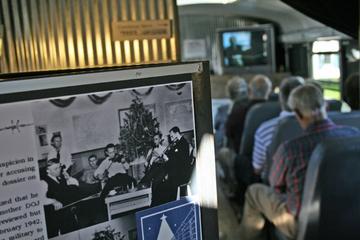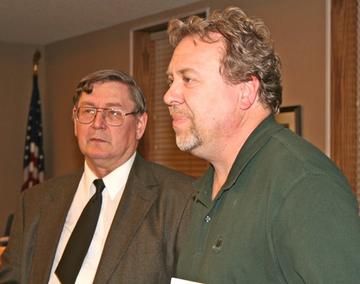
 |
|
This article appeared in
the Marshal Democrat News, Saline County, MO Part 1, April 15, 2007:
|
 |
A display aboard the BUS-eum 2, a mobile museum based in St. Paul, Minn., shows a string ensemble playing. In the background, area residents watch a Dateline program about Germans who were transported from Latin American countries to the U.S. during World War II and detained in camps around the country. According to museum Director Michael Luick-Thrams the displays are meant to both tell a story and evoke the family lives that were disrupted by internment. |
Editor's note: This is the first of two stories about the BUS-eum visit to Marshall. Part 2 will focus on a community forum discussion that was held in conjunction with the mobile museum visit.
Area residents said they were intrigued by a traveling museum that parked at the Marshall Public Library Monday, April 16, to tell the story of German civilians who were detained in camps around the U.S. during World War II.
The mobile museum, BUS-eum 2, is a service of TRACES Museum, Center for History in Culture in St. Paul, Minn.
The display brought to Marshall, "Vanished: German-American Civilian Internment, 1941-1948," tells a story not many are familiar with, according to the display.
In addition to explanatory material, the museum included period memorabilia -- a man's hat, a child's blue dress, a washboard, a doll and similiar items -- intended to evoke the family lives that were disrupted by internment during the war.
According to the display the U.S. detained about 11,000 Germans, including German-Americans, during the war.
The BUS-eum display included regular showings of an NBC Dateline program that focused on the forceable relocation of more than 4,000 Germans from Latin American countries to the U.S. camps, an aspect of the war that has received little attention over the years, according to the show.
Reactions from people who visited the exhibit were a mix of concern about past wrongs and memories of the fear that contributed to those practices.
Pat Hammer of Malta Bend said she was 10 years old when the war ended and remembers well what life in Saline County was like then, but she said she was not aware of the camps or the internment of civilians.
"This is really interesting," she said.
Lucille Hisle of Miami said the museum was instructive and thought-provoking.
"It made me wonder if that Green Zone in Iraq is the same thing," she said. "Of course, you have to understand both sides. Gen. Marshall was thinking about the protection of the American people."
Marvin Wilhite, local genealogist and historian, said the internment program was a shame.
"It's one of the black eyes that this country needs to face," he said.
John Schulz echoed Hisle's concern about the possible similarities between the past and present.
"It's a bit of history we don't hear about," he said. "It's a shame. It makes you wonder if -- if they did something like that in World War II, what about the war on terrorism?"
Dale Bean said it was important to keep in mind the times in which the internment occurred.
"It was definitely the wrong thing to do, but it was a different time then," he said. "Fear makes people do things they wouldn't normally do."
The bus, with its dark olive green exterior, painted barbed wire and corrugated metal interior paneling, attempted to evoke in visitors a sense of what detainees experienced, Luick-Thrams said.
"People love the bus," he said. "It's unique."
The two-bus program has visited 600 towns in eight states and has been visited by more than 60,000 people in the past couple of years, he said.
"We go where the people are," he said.
Several people who viewed the World War II internment exhibit, "Vanished," at the Marshall Public Library Monday, April 16, said they found the videos and museum displays instructive.
But the most important result of the visit from the mobile museum for some was the excuse it gave local residents to meet and discuss their own memories and perspectives, local and global, of the war.
At 7 p.m. Marshall High School history teacher Paul Gieringer and local historian and genealogist Marvin Wilhite led a community discussion forum.
 |
From left, Marvin Wilhite and Paul Gieringer discuss their research on World War II POW camps in Missouri. (Photo by Eric Crump/Democrat-New) |
Gieringer wrote his master's degree thesis on the subject of prisoner-of-war camps in Missouri, a topic he first became interested in when fellow teacher Dave Nelson gave him a copy of an article that mentioned the Marshall camp, which was located where MHS is now.
And Wilhite reported on research in census records to see if any Saline County residents might have been in danger of being sent to the internment camps featured in the "Vanished" exhibit.
Gieringer said not a great deal of information is available about the Marshall camp.
"I've never seen a picture of the camp in Marshall," he said. "That would be priceless."
He said records are sometimes difficult to find about any of the camps.
Newspapers of the time, for instance, provide scant evidence because the government did not release much information.
And the camp facilities are long gone, in most cases, he said.
But while doing his research he heard many good stories about the camps, about how prisoners were treated and how local communities reacted to their presence.
He said prisoners of war in the U.S. were well treated. They were required to work, but they were well-fed and were paid for their labor.
Americans for the most part co-existed well with the prisoners, but he cited one unsigned letter sent to the State Department objecting to the location of camps in the St. Louis area because of the large German-American population there.
The letter-writer apparently feared collaboration between German-American civilians and German soldiers.
Wilhite said his research indicated there were about 85 to 90 families of German origin in Saline County by 1930, but most were older when they arrived and only about six people were left by the time the civilian internment camps were created during the war.
He said there was no proof that anyone of German descent from Saline County was detained by the government, though one or two former Saline County residents died in St. Louis, where internment camps were located.
The information and stories provided by Gieringer and Wilhite prompted members of the audience to share their recollections of the war and how it affected area residents at the time.
Lena Wilhite, Marvin Wilhite's mother, said she remembered Tom Futaba, known at the time as "Tommy the Jap."
"When Pearl Harbor was bombed he hid out because he was afraid they'd send him to Japan," she said.
Dale Bean noted that a number of Americans from Axis countries served in the U.S. military with distinction during the war.
"I'm sure they wanted to prove they were on our side,," he said.
| Home |